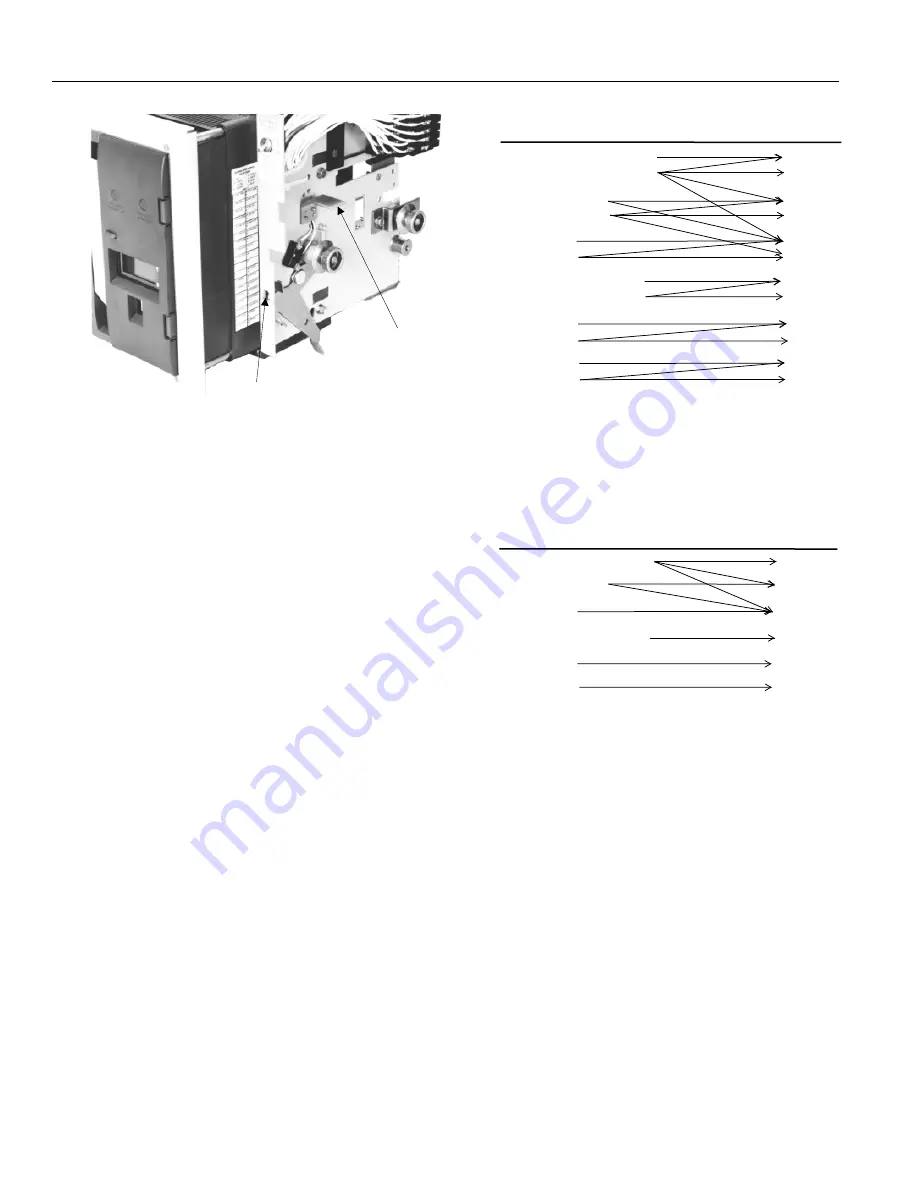
Power Break® II Devices
Draw-Out Device Installation
—
Table 4. Illustration of the rejection-scheme logic, showing which switches may be
installed in which substructures.
Rejection
Feature
Draw-Out
Position
Indicator
—
Figure 3. Right side of the device, showing the rejection feature, draw-out position indicator, and
electric operator cutoff switch.
Draw-Out Position Indicator. Indicates whether the device is
in the connected, test, or disconnect position.
Electric Operator Cutoff Switch. Prevents cycling of the
spring-charging motor during installation or removal of a
device.
Draw-Out Interlock. This feature trips a closed device if the
wrench interlock is deliberately defeated. The device is
tripped before the primary disconnects part as the device is
racked out and before the primary disconnects engage as the
device is racked in.
Rejection Feature. This feature prevents insertion of a device
into a substructure of lower ampere rating or higher short-
circuit rating. It does not reject a device with incompatible
control wiring. See the label on the device or Tables 1 or 2 for
the proper substructure catalog number. (Also shown in
Figure 8.)
Tables 3 and 4 illustrate the rejection scheme logic. Note that
devices may be safely used in higher-rated substructures.
However, local and industry codes and standards require that
conductors be sized to the substructure. Therefore, installing
devices in substructures with higher ratings is possible, but
not economical.
Draw-Out Padlock Accessory. When a padlock is installed, this
feature works with the racking shaft lockout plate to prevent
engagement of the racking shaft wrench.
Shutter Actuator. A stud actuates the optional shutter
accessory.
By-Pass Switch Actuator. Operates the optional by-pass
switch accessory.
Lifting Bar. The Lifting Bar, catalog number TDOLB, is
available for safe handling of the draw-out device, as
illustrated in Figures 4 and 5.
Note: In the circuit breaker catalog number, replace “X” with "G" for
EntelliGuard ® Trip unit or “B” for MicroVersaTrip Plus™ or MicroVersaTrip
PM™ Trip Units or with “D” for Power+™ Trip Units
—
Table 3. Illustration of the rejection-scheme logic, showing which circuit breakers may
be installed in which substructures.
Note: In the switch catalog number, replace “X” with "W"
for EntelliGuard ®
Control
U
nit
s
or with
“
Y
” for Power+™
Control
Unit
s
SPSDOS08
SPSDOS16
SPSDOS20
SPSDOS25
SPSDOS30
SPSDOS40
SSD08X
SSD08X
202, X204, X208
SSD16X
210, X216
SSD20X
220
SSD25X
210, X220, X325
SSD30X
330
SSD40X
440
Substructure
SPSDOS08
SPSDOS16
SPSDOS20
SPSDOS25
SPSDOS30
SPSDOS40
Substructure
Breaker
SSD08X
SSD08X
202, X204
, X208
SHD08X
202, X204, X208
SSD16X
210,X216
SHD16X
210,X216
SSD
20X
2
2
0
SHD
20X
2
2
0
SSD25
X210,X220,X325
SHD25X
210,X220,X325
SSD30X
330
SHD30X
330
SSD40X
440
SHD40X
440
SP
H
DOS08
SP
H
DOS16
SP
H
DOS20
SP
H
DOS25
SP
H
DOS30
SP
H
DOS40
Switch
2




















